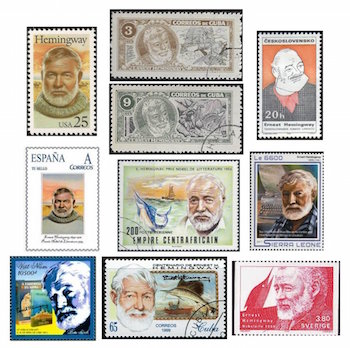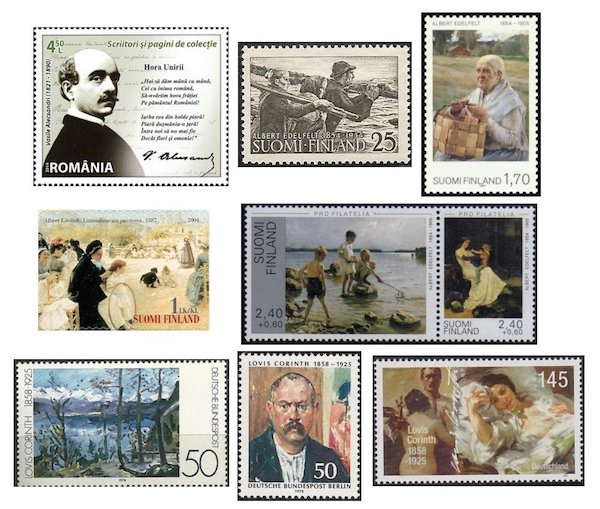The Arts on Stamps of the World — July 21
An Arts Fuse regular feature: the arts on stamps of the world.

By Doug Briscoe
Top dog today is Ernest Hemingway (July 21, 1899 – July 2, 1961), who gets Collage #1 all to himself, but I was surprised to learn that another American writer, the poet Hart Crane, who has no stamps at all, was born on exactly the same day, July 21, 1899. (He died at a much younger age on April 27, 1932.)
The Moldavian Vasile Alecsandri (21 July 1821 – 22 August 1890) was an important political figure who fought to preserve his people’s culture, but for our purposes he was also poet, playwright, and collector of folk songs. After a preliminary education he went at age thirteen to Paris and wrote his first literary essays in the French language. He took part in the 1848 revolution insofar as helping to seek Moldavian independence from Russia, but on the movement’s failure he returned to Paris. In 1850 he came back to his homeland, writing poems and plays and seeing the wished-for unification of Moldavia with Wallachia. He also wrote the words to the national anthem of the Romanian monarchy.
We have today three consecutive painters of the same generation. First born was Finnish painter Albert Edelfelt (21 July 1854 – 18 August 1905). His father was an architect. In Paris Edelfelt was a student of Jean-Léon Gérôme and met John Singer Sargent. One of the first Finns to achieve international success as a painter, Edelfelt made portraits of such prominent figures as Louis Pasteur and the soprano Aino Ackté (his portrait of her appears on her postage stamp, as we saw back in April). As for his own stamps, Edelfelt’s work shows up on a Finnish one as early as 1954: The Outer Archipelago (1898). Others show his Old Woman With Basket, The Luxembourg Gardens, Paris (1887), and, on the se-tenant issue: Boys Playing on the Shore (1884) and Queen Blanche (1877). Edelfelt was a friend of the poet Johan Ludvig Runeberg and illustrated his epic poem The Tales of Ensign Stål. One of Edelfelt’s students was Léon Bakst.

Four years younger to the day was the German Lovis Corinth (21 July 1858 – 17 July 1925). As I mentioned yesterday, two of the stamps showing Corinth’s work come from the same sets as ones we saw for Max Liebermann. This is fitting, as Corinth succeeded Liebermann as president of the Berlin Secession group (from 1915). Like Liebermann, he was also avidly interested in printmaking. He was born Franz Heinrich Louis in Prussia and studied art in Munich and Paris. He adopted the name Lovis Corinth on his return to Königsberg in 1888. From 1890 he lived in Berlin. Well after his death his paintings were among those cited as “degenerate” and displayed in the notorious 1937 Munich exhibition. The stamps show Easter at Walchensee, a lake in Bavaria where Corinth had a home, one of his many self-portraits, this one Self-Portrait Without Collar (1900), and the last stamp combines two pictures, Self-Portrait With Model (1903) and Morning Sun (1910).
The third artist of the period, two years younger than Corinth, was Antoni Kamieński (21 July 1860 – 12 September 1933), though he seems to have worked more as an illustrator and engraver than as a painter. Both Kamieński and Corinth studied with William-Adolphe Bouguereau in Paris. Kamieński also wrote a novel called Spring Morning, published in 1907. The Polish stamp shows his piece A Moment of Decision, wherein a well-dressed young woman is mailing a letter, presumably one of some importance.

The important Belgian auteur Jacques Feyder (21 July 1885 – 24 May 1948) began directing films as early as 1916, though his service in the last two years of World War I interrupted his work. After the war he quickly earned a reputation as an innovative director and also began writing screenplays. He adopted French nationality in 1928 but was in Hollywood the next year directing Greta Garbo in her last silent, The Kiss. Back in France in 1933, he helmed three of his best films in succession, Le Grand Jeu (1934), Pension Mimosas (1935), and La Kermesse héroïque (aka Carnival in Flanders, 1935). He did more work in Britain and Germany and made his last movie in Switzerland in 1942.
The best known work of German novelist Hans Fallada (born Rudolf Wilhelm Friedrich Ditzen on 21 July 1893, died 5 February 1947) is probably Little Man, What Now? (1932), the story of the difficulties of existence in the final years of the Weimar Republic. Fallada himself had a troubled life, suffering a severe accident when he was 16 and becoming addicted to painkillers as a result. His tendency to isolation, lack of self-confidence, and homosexuality led to a number of suicide attempts. He lost a brother in World War I and served two prison terms for thefts to support his habit. But by 1928 he was free of the addiction and was able to embark on a successful career as a writer.
Unfortunately the curse returned in the form of Nazism, forcing Fallada to a tightrope walking act of writing innocuous children’s stories or government-approved work while trying to maintain his integrity. He was even committed to an insane asylum for a time. After the war he fell back into addiction, further weakening his health. Before his death he was able to complete the anti-Nazi novel Every Man Dies Alone (1947).

A tip of the hat to Canadian thinker Marshall McLuhan (July 21, 1911 – December 31, 1980), who gave us the phrases “the medium is the message” and “the global village”, along with much more in the way of our perception of culture and its interaction with technology.
In the year of his death, the island of São Tomé issued two sheets in honor of the late Robin Williams (July 21, 1951 – August 11, 2014). I show the single stamp from the first sheet and the entirety of the second.
A graduate of the University of Massachusetts with a B.A. in English, Doug Briscoe worked in Boston classical music radio, at WCRB, WGBH, and WBUR, for about 25 years, beginning in 1977. He has the curious distinction of having succeeded Robert J. Lurtsema twice, first as host of WGBH’s weekday morning classical music program in 1993, then as host of the weekend program when Robert J.’s health failed in 2000. Doug also wrote liner notes for several of the late Gunther Schuller’s GM Recordings releases as well as program notes for the Boston Classical Orchestra. For the past few years he’s been posting a Facebook “blog” of classical music on stamps of the world, which has now been expanded to encompass all the arts for The Arts Fuse.
